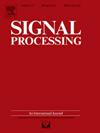Constrained coupled CPD of complex-valued multi-slice multi-subject fMRI data
IF 3.4
2区 工程技术
Q2 ENGINEERING, ELECTRICAL & ELECTRONIC
引用次数: 0
Abstract
Considering that the four-way complex-valued multi-subject fMRI tensor inevitably contains the large unwanted brain-out voxels, this paper innovatively combines multi-subject brain-in fMRI data with same slices as three-way multi-slice multi-subject fMRI tensors and thus brain-out voxels are discarded. Additionally, adjacent-slice fMRI tensors can be further merged, and multi-slice multi-subject fMRI tensors of N groups are formed, and are jointly decomposed by a novel spatiotemporally constrained coupled canonical polyadic decomposition (CCPD) by sharing temporal and subject modes but allowing slice-group differences. The spatial phase sparsity and orthonormality constraints are added on rank-R least-squares fit of N-slice-group shared spatial maps (SMs) to reduce noise effect, cross-talk among components and inter-subject spatial variability which naturally occur in complex-valued fMRI data. To alleviate CCPD model and allow inter-subject temporal variability, the alternating shift-invariant rank-1 least-squares optimization is performed to update shared time courses (TCs), subject-specific time delays and intensities. Results of simulated and experimental fMRI analyses demonstrate that the proposed methods with different N groups outperformed the competing methods by 6.21 %∼23.61 % in terms of shared task-related SMs and TCs. The proposed methods with N=45 and N=3 respectively obtain the best performance in the presence of strong noise levels and slightly strong noise levels cases.
复杂值多层多主体fMRI数据的约束耦合CPD
考虑到四向复值多主体fMRI张量不可避免地包含大量不需要的脑残体素,本文创新性地将多主体脑残数据与三向多层多主体fMRI张量进行相同切片的组合,从而丢弃脑残体素。此外,邻接片fMRI张量可以进一步合并,形成N个群的多片多主体fMRI张量,并通过共享时间和主体模式但允许片群差异的新型时空约束耦合正则多进分解(CCPD)进行联合分解。在n -片群共享空间图(SMs)的秩r最小二乘拟合中加入空间相位稀疏性和正交性约束,以降低复杂值fMRI数据中自然存在的噪声效应、分量间的串扰和主体间的空间变异性。为了减轻CCPD模型的影响并允许受试者间的时间变化,采用交替移位不变秩1最小二乘优化来更新共享时间过程(tc)、受试者特定时间延迟和强度。模拟和实验fMRI分析结果表明,不同N组的方法在共享任务相关的SMs和tc方面比竞争方法高出6.21% ~ 23.61%。当N=45和N=3时,所提出的方法在强噪声和弱噪声情况下获得最佳性能。
本文章由计算机程序翻译,如有差异,请以英文原文为准。
求助全文
约1分钟内获得全文
求助全文
来源期刊

Signal Processing
工程技术-工程:电子与电气
CiteScore
9.20
自引率
9.10%
发文量
309
审稿时长
41 days
期刊介绍:
Signal Processing incorporates all aspects of the theory and practice of signal processing. It features original research work, tutorial and review articles, and accounts of practical developments. It is intended for a rapid dissemination of knowledge and experience to engineers and scientists working in the research, development or practical application of signal processing.
Subject areas covered by the journal include: Signal Theory; Stochastic Processes; Detection and Estimation; Spectral Analysis; Filtering; Signal Processing Systems; Software Developments; Image Processing; Pattern Recognition; Optical Signal Processing; Digital Signal Processing; Multi-dimensional Signal Processing; Communication Signal Processing; Biomedical Signal Processing; Geophysical and Astrophysical Signal Processing; Earth Resources Signal Processing; Acoustic and Vibration Signal Processing; Data Processing; Remote Sensing; Signal Processing Technology; Radar Signal Processing; Sonar Signal Processing; Industrial Applications; New Applications.
 求助内容:
求助内容: 应助结果提醒方式:
应助结果提醒方式:


